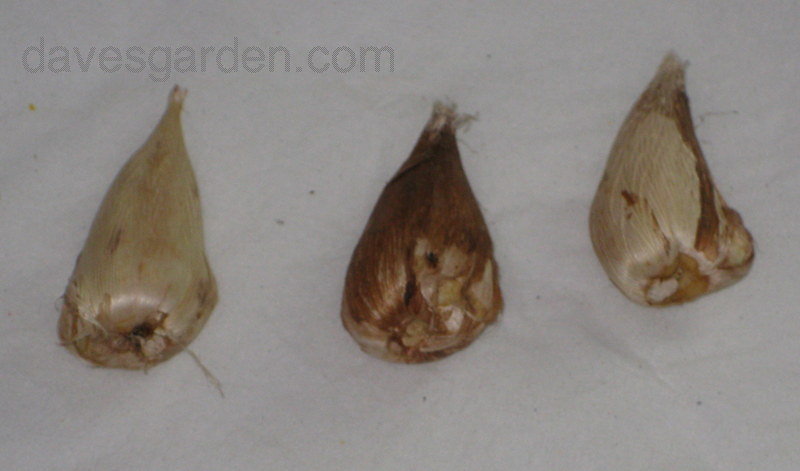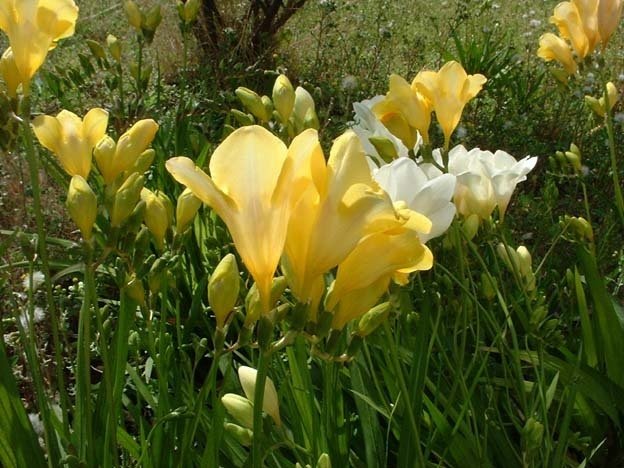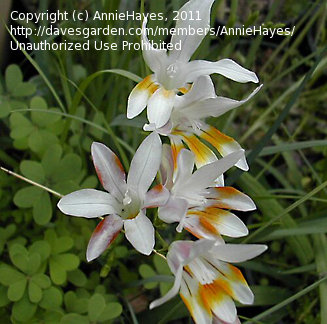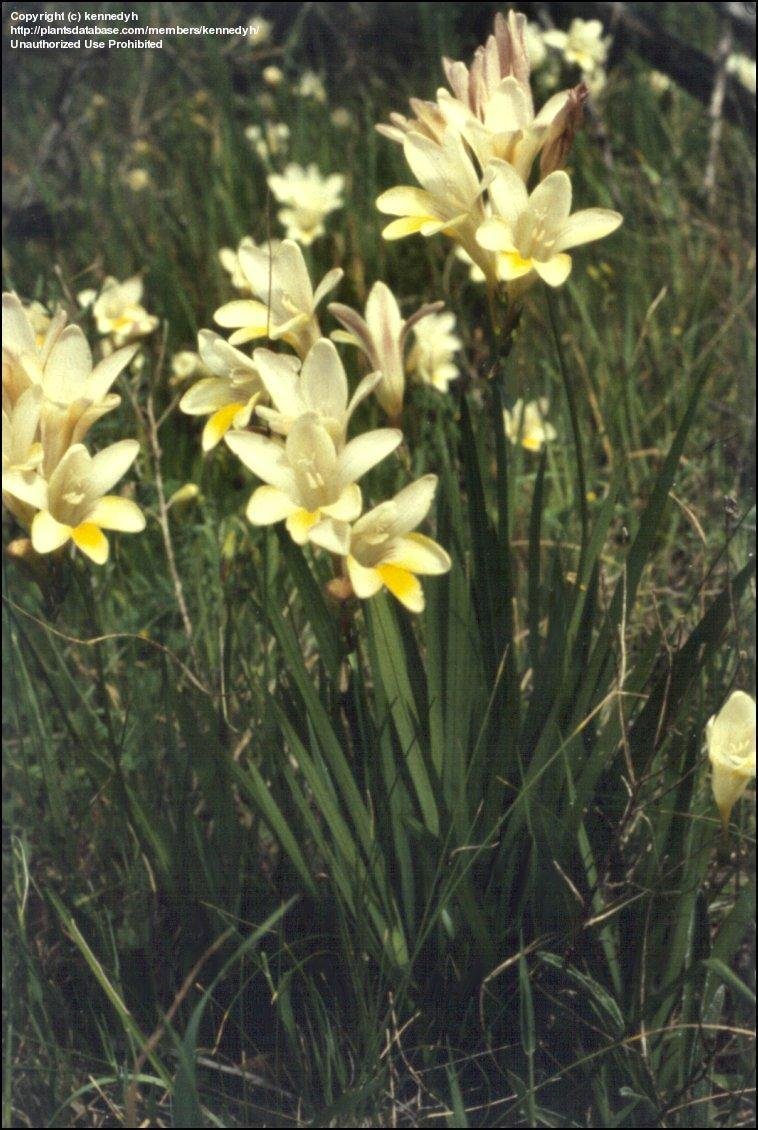





Freesia are famous for their delectably subtle sweet fragrance and their elegant narrow stems. They are one of the standbys of the florist, showing up reliably in corsages and lovely indoor arrangements. Growing freesia yourself, from corms, is not as hard as you might think. If I did it, then so can you!
Freesia is a small genus native to South Africa in the Iridaceae family. Like some other common garden ornamentals, freesia grow from corms, not bulbs. (Other familiar flowers from corms include crocus, gladiolus and crocosmia.) A corm is a mass of stem tissue--corms don't have onion-like layers of stored energy. So they need a little more attention that first year than bulbs do.
Growing freesia at home was just too challenging for me in New England. The corms cannnot be allowed to freeze, so I used to plant them after the last frost date in pots outside on the patio. Then it would rain and rain and rain. Although I was no longer facing the tragedy of frozen freesia sprouts, the great sadness of mushy corms cannot be adequately expressed in words.

Steps to Freesia Success
Step 1: select plump healthy corms. The corms I finally convinced to produced freesia blooms were a cheap, impulse purchase. Imagine if some of those I had purchased from specialty companies had grown!
Step 2: plant your corms close together--about 2 inches or 5 cm apart--in quickly draining soil. Like most bulbs, corms and tubers, freesia will rot if in standing water or even in constantly damp soil. And unlike the northern bulbs I was familiar with, freesia corms cannot survive sub-zero temperatures, or even sub-zero Centigrade!
S teps 3, 4, 5 and 6: wait and water, wait and water, then maybe wait a little more and you'll see sprouts. Continue to water and seriously think about staking your shoots. The long, limp stems will flop over the edge of the pot indoors, which you may find unattractive. Once you have shoots, you might add some fertilizer; corms are not as high in sugars as bulbs, and do not have everthing the plant needs (the way true bulbs do). If you are above zone 9 and have planted your corms outside (in a sunny and quickly draining area), you probably won't need to stake them.
teps 3, 4, 5 and 6: wait and water, wait and water, then maybe wait a little more and you'll see sprouts. Continue to water and seriously think about staking your shoots. The long, limp stems will flop over the edge of the pot indoors, which you may find unattractive. Once you have shoots, you might add some fertilizer; corms are not as high in sugars as bulbs, and do not have everthing the plant needs (the way true bulbs do). If you are above zone 9 and have planted your corms outside (in a sunny and quickly draining area), you probably won't need to stake them.
Step 7: one day when you least expect it, you'll notice that one of those limp floppy shoots is actually a stalk bearing buds! The bud closest to the bottom of the stalk will open first, then they will open up towards the tip, just like crocosmia.
Step 8: once the buds have started to open, you may cut them to put in a vase if you wish (especially if you're growing them inside). They will continue to open one by one, turning to face the sun as they grow. Opinions vary as to whether removing the spent blooms in the middle of the stalk will help the ones farther up to last longer or open more fully. It certainly looks more attractive to me to remove the dead flowers.
From the time in the mid 18th century when the first specimens (collected in South Africa) made their way to the greenhouses of Europe until 1982 when geneticists and botanists organized them all and put them into their own genus,  freesia have been part of gardeners' collections, that's two-and-a-half centuries. Although they were initially included with the gladiolus, we now consider them to be their own species, and hybridizers have been breeding and hybridizing as fast as possible. Two genera were once considered to be something different but have now been added to the Freesia genus: Anomatheca (formerly known as "False freesia") and Tritonia, known as "Flaming Freesia." (These changes are not relected in PlantFiles, however.)
freesia have been part of gardeners' collections, that's two-and-a-half centuries. Although they were initially included with the gladiolus, we now consider them to be their own species, and hybridizers have been breeding and hybridizing as fast as possible. Two genera were once considered to be something different but have now been added to the Freesia genus: Anomatheca (formerly known as "False freesia") and Tritonia, known as "Flaming Freesia." (These changes are not relected in PlantFiles, however.)
Freesia blooms in just about every color
In general, the flowers of freesia tend to be funnel-shaped, where the individual petals are partially or mostly fused together, but they may appear as separate petals in some species. The freesia genus includes F. leichtlinii (many modern hybrds have F. leichtlinii in their parentage), F. alba (white), F. caryophyllacea (cream to yellow), F. viridis (green), F. grandiflora, F. fucato (see picture, left) and F. corymbosa. The genus also includes Anomatheca (now called F. laxa) which have flat flowers with distinct petals and Tritonia (now called Freesia). All colors except true blue are represented, as well as interestingly bicolored blooms. (In fact, the freesia x hybridia in the top right picture is called 'Royal Blue', but as you can see it's more of a purple-blue.)

Freesia do, of course, have named cultivars ('Oberon' is orange and 'Magdalena' is yellow) like other hybridized plants, but they are often sold as simply "red double freesia" or "mixed single freesia." Freesia are in the Iridaceae family along with Tulip, Daffodil and Amaryllis.
Alice Notten of Plantzafrica notes dryly that "that overwatering, particularly of container-grown species, will soon lead to rotting." Don't say I didn't warn you.
keeping them for next year
If you live where it rarely or never freezes, you can leave your freesia in the ground year-round, where they should bloom every spring and multiply, by spreading fertilized seed and by corm-lets, which are (as you probably guessed) baby corms. Otherwise, you can cut the foliage off when it has yellowed and withered. (Like other, more familar plants from bulbs or corms, the foliage is storing energy for next year.) Dig and store the corms in a cool, dry, dark place. However, the corms are not expensive. I didn't save mine--I'm buying different colors for next year. And now that I know I can do it, I'll try again with mail-ordering my favorite colors.
Web sources suggest that the white and pale yellow varieties will be the most fragrant.
photos: the first two are courtesy of vossner, next Jean Tosti (via the GNU Free documentation License), F. fucato c. AnniesAnnuals.com and the last one is by kennedyh. (Gabludlow at Flickr.)
More information and planting guides:
http://www.sarahraven.com/how-to/growing-flowers/4/how-grow-freesias.
http://www.guide-to-houseplants.com/freesia-flower.html
http://www.easytogrowbulbs.com//g-12-freesia-planting-guide.aspx
Copyright © www.100flowers.win Botanic Garden All Rights Reserved